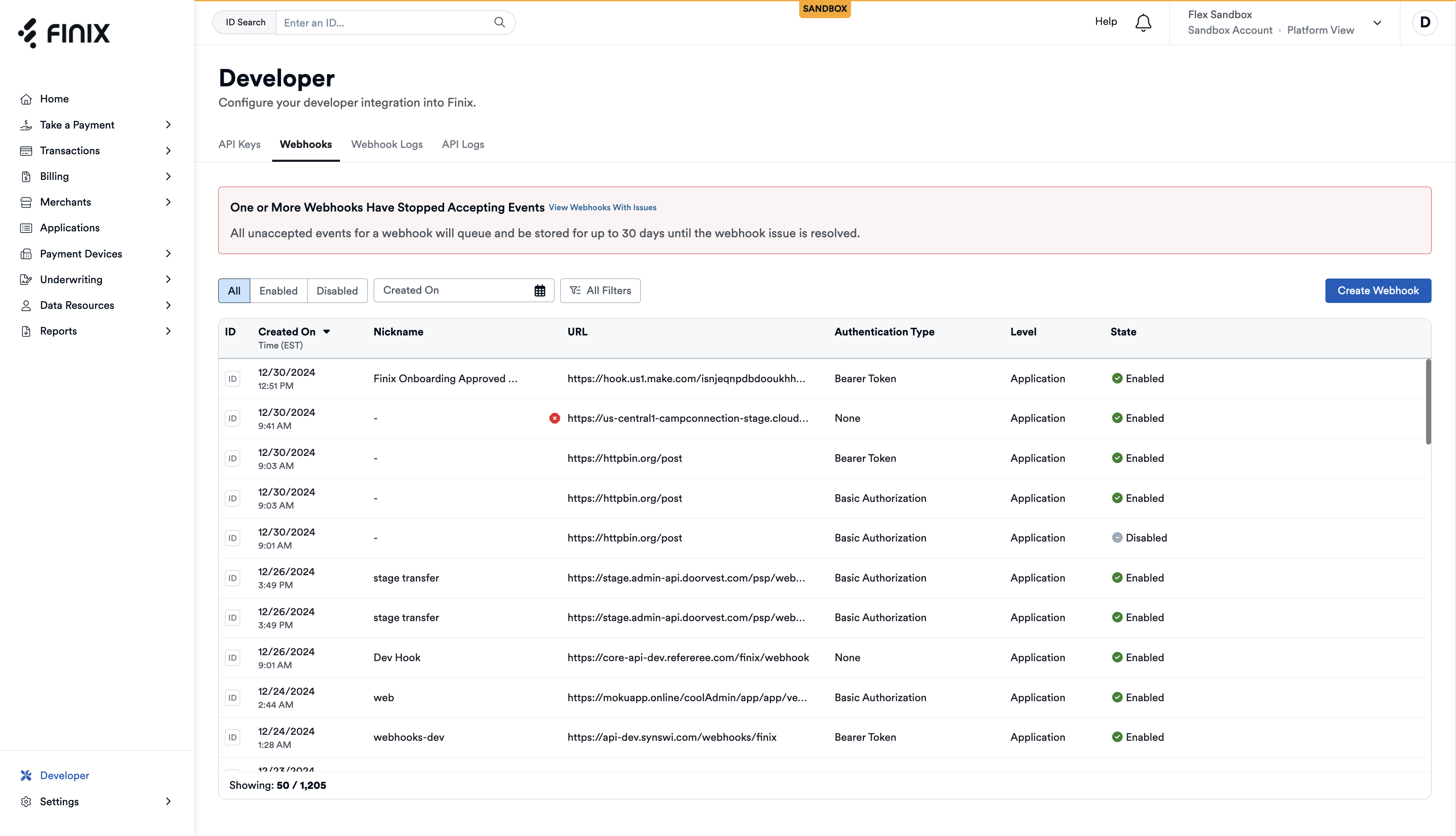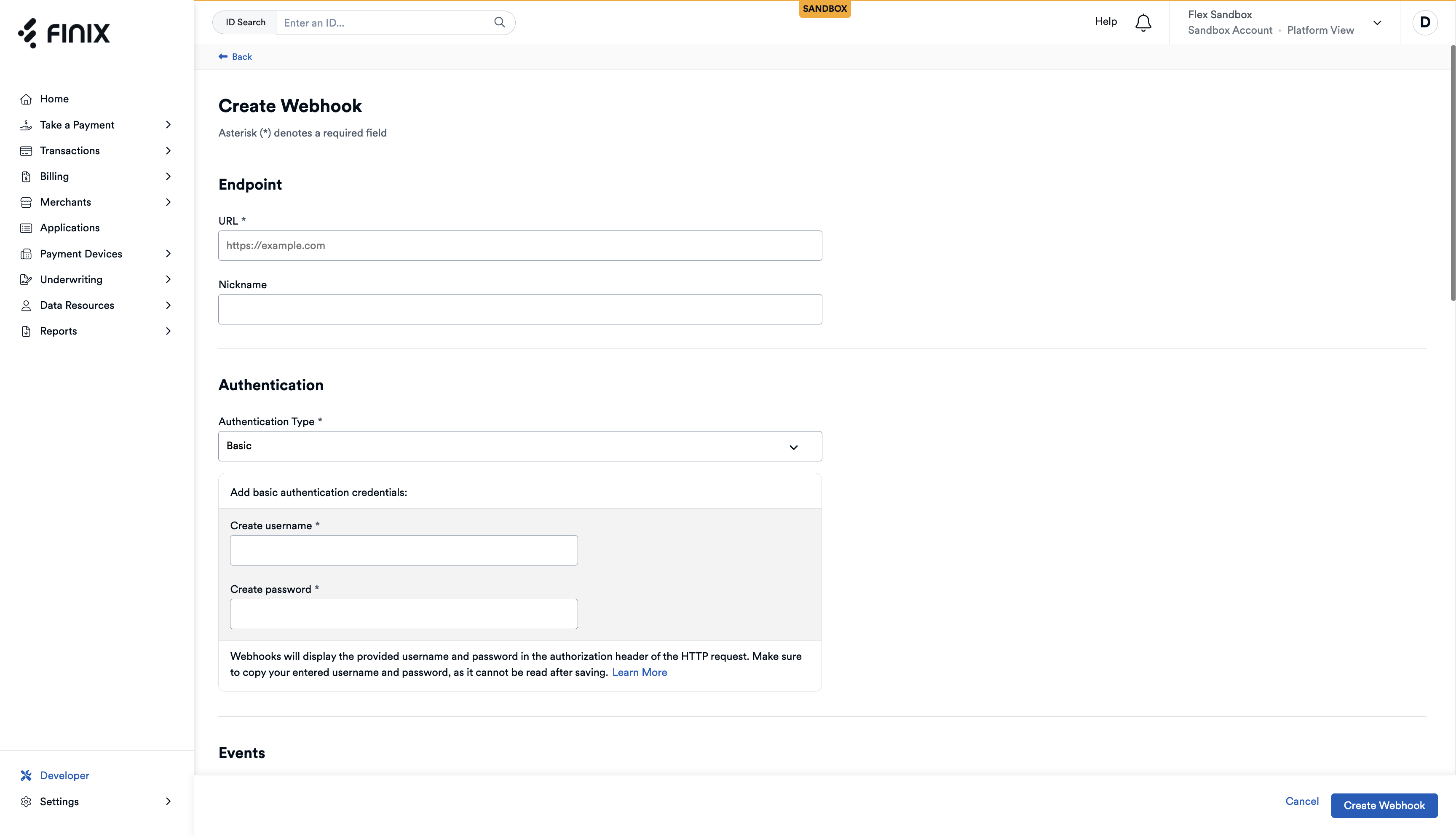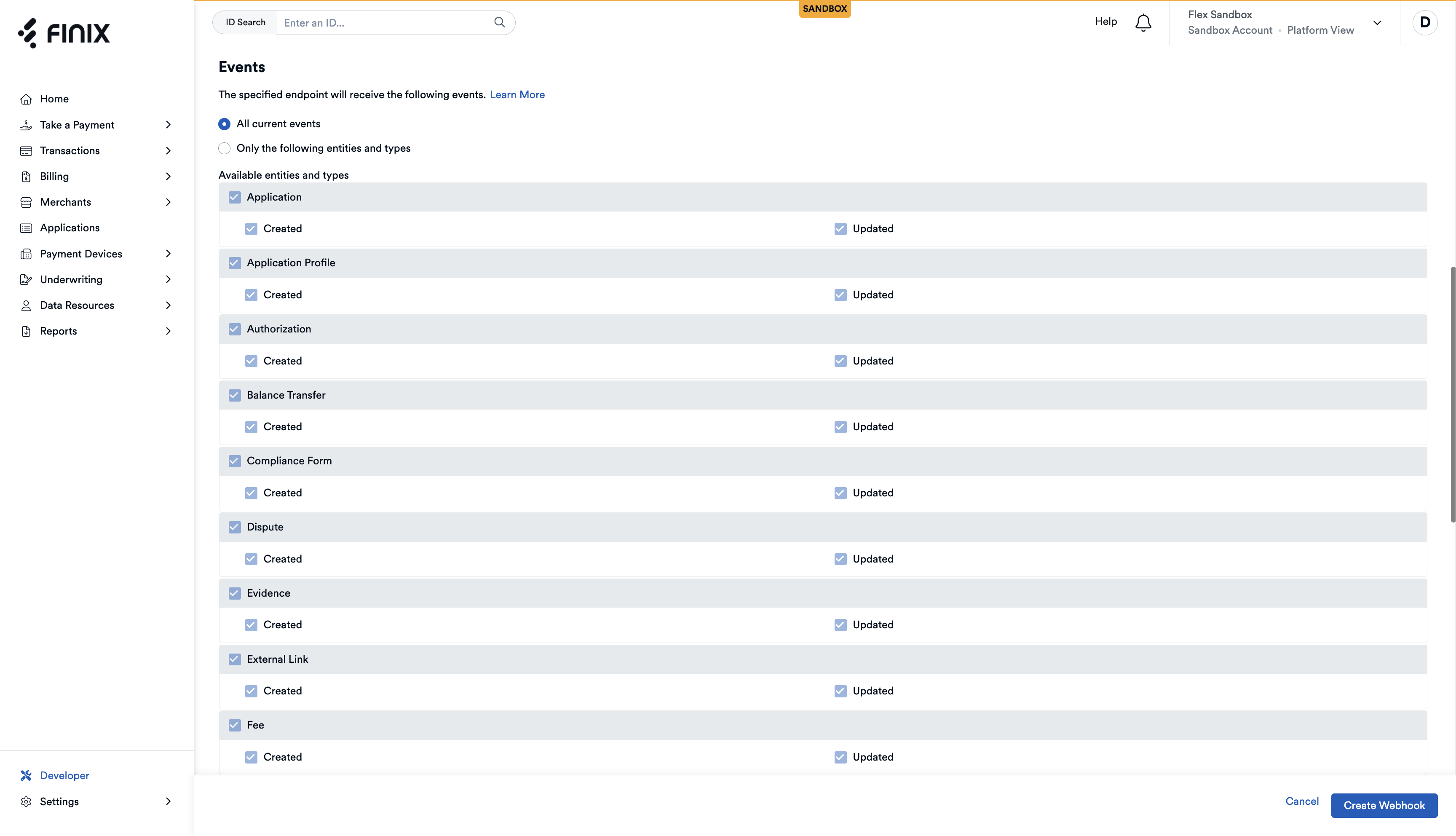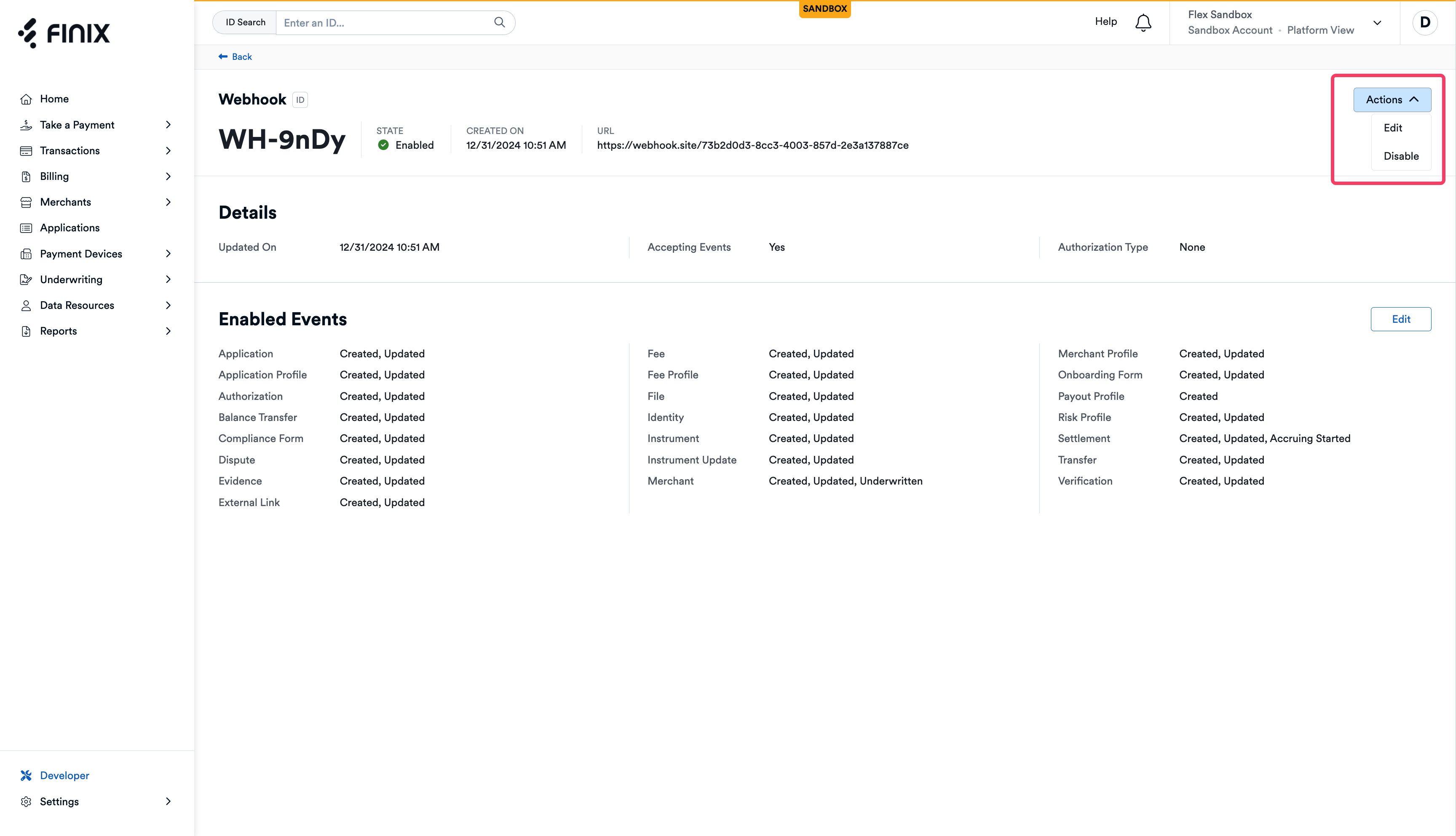Use webhooks to subscribe to automated notifications (also known as events) from Finix.
When an event is triggered, Finix sends an HTTP POST request to the endpoint URL configured in the webhook. Rather than requiring your servers manually poll Finix's API to learn about changes to your resources, webhooks push notifications to the endpoint URL to notify you proactively.
With webhooks, you can keep up with asynchronous state changes. Examples of changes include:
Transferis created.Merchantis approved.Disputesare won.
Finix lets you create and update webhooks with Finix's API. This can be helpful for companies that want to manage webhook through their own dashboard or developer tools.
When you create a webhook via API, Finix will send an empty test event to the endpoint URL configured in the webhook. The configured URL must respond to this event successfully to let Finix know the URL is valid, at which point Finix will enable the webhook. See Validating Webhooks for more information.
To create a webhook, send a POST request to Finix's /webhooks endpoint.
curl "https://finix.sandbox-payments-api.com/webhooks" \
-u USsRhsHYZGBPnQw8CByJyEQW:8a14c2f9-d94b-4c72-8f5c-a62908e5b30e \
-H 'Accept: application/hal+json' \
-H 'Content-Type: application/json' \
-H 'Finix-Version: 2022-02-01' \
-X POST \
-d '{
"url": "https://webhook.site/73b2d0d3-8cc3-4003-857d-2e3a137887ce"
}'{
"id": "WHid2GDsvQaHhnLQa1HCjNiR",
"created_at": "2024-12-31T15:11:43.41Z",
"updated_at": "2024-12-31T15:11:43.41Z",
"application": "APgPDQrLD52TYvqazjHJJchM",
"authentication": {
"type": "NONE"
},
"enabled": true,
"enabled_events": [],
"is_accepting_events": true,
"nickname": null,
"previous_secret_expires_at": null,
"secret_signing_key": "1676b0aa7f96e7f2cb3ef92ea266a13a534ad06593e930152343a36d14bdc3c5",
"url": "https://webhook.site/************************************",
"_links": {
"self": {
"href": "https://finix.sandbox-payments-api.com/webhooks/WHid2GDsvQaHhnLQa1HCjNiR"
},
"application": {
"href": "https://finix.sandbox-payments-api.com/applications/APgPDQrLD52TYvqazjHJJchM"
}
}
}When creating a webhook, specify the authentication type (authentication.type) that Finix should use when sending events to the endpoint URL. When you add an authentication type, Finix will add an Authorization header to events sent to the configured endpoint URL. Your server can use the Authorization header to verify that the event came from Finix.
Finix supports two authentication types:
- Basic Authentication: Finix will send the webhook event with Basic Authentication.
- Bearer Token Authentication: Finix will send the webhook with a Bearer Token.
Finix uses the standard Basic authentication format. When you set authentication.type to BASIC, each webhook event is sent with a Authorization header formatted as Authorization: Basic <Base64>.
When creating the webhook, you will include username and password values that Finix will use for the Authorization header.
curl "https://finix.sandbox-payments-api.com/webhooks" \
-u USsRhsHYZGBPnQw8CByJyEQW:8a14c2f9-d94b-4c72-8f5c-a62908e5b30e \
-H 'Accept: application/hal+json' \
-H 'Content-Type: application/json' \
-H 'Finix-Version: 2022-02-01' \
-X POST \
-d '{
"authentication": {
"type": "BASIC",
"basic": {
"username": "USsRhsHYZGBPnQw8CByJyEQW",
"password": "8a14c2f9-d94b-4c72-8f5c-a62908e5b30e"
}
},
"url": "https://webhook.site/73b2d0d3-8cc3-4003-857d-2e3a137887ce"
}'To create the Authorization header included in events sent to that URL, Finix:
- Combines the
usernameandpasswordwith a colon
(e.g.,USsRhsHYZGBPnQw8CByJyEQW:8a14c2f9-d94b-4c72-8f5c-a62908e5b30e) - Base64-encodes the string
(e.g.,VVNzUmhzSFlaR0JQblF3OENCeUp5RVFXOjhhMTRjMmY5LWQ5NGItNGM3Mi04ZjVjLWE2MjkwOGU1YjMwZQ==) - Adds the value to the Authorization Header with the Basic scheme (e.g,
Authorization: Basic
VVNzUmhzSFlaR0JQblF3OENCeUp5RVFXOjhhMTRjMmY5LWQ5NGItNGM3Mi04ZjVjLWE2MjkwOGU1YjMwZQ==)
Finix supports sending OAuth 2.0 Bearer Tokens RFC 6750. These are opaque strings that is up to the server to interpret. When you set authentication.type to BEARER, each webhook event is sent with a Authorization header formatted as Authorization: Bearer <your-token>.
With Bearer Token-authenticated webhooks, Finix sends events with tokens exactly as you provided. It is up to your system to perform any further calculation or validation of the value.
curl "https://finix.sandbox-payments-api.com/webhooks" \
-u USsRhsHYZGBPnQw8CByJyEQW:8a14c2f9-d94b-4c72-8f5c-a62908e5b30e \
-H 'Accept: application/hal+json' \
-H 'Content-Type: application/json' \
-H 'Finix-Version: 2022-02-01' \
-X POST \
-d '{
"authentication": {
"type": "BEARER",
"bearer": {
"token": "U3VwZXIgc2VjcmV0IGVuY29kZWQgdG9rZW4="
}
},
"url": "https://webhook.site/73b2d0d3-8cc3-4003-857d-2e3a137887ce"
}'From this example, your server will receive events with the header authorization: Bearer U3VwZXIgc2VjcmV0IGVuY29kZWQgdG9rZW4=.
When configuring webhooks, it is common for customers to subscribe to all event types and ignore those they do not care about. However, Finix does support subscribing to only specific webhook events through the Webhook's enabled_events field.
To filter the events sent to a webhook, create or update the Webhook with the enabled_events you want to receive. In this example, we'll update an existing webhook to receive 3 events: Transfer Created, Merchant Created, and Merchant Underwritten.
curl "https://finix.sandbox-payments-api.com/webhooks/WHid2GDsvQaHhnLQa1HCjNiR" \
-H "Content-Type: application/json" \
-H 'Finix-Version: 2022-02-01' \
-u USsRhsHYZGBPnQw8CByJyEQW:8a14c2f9-d94b-4c72-8f5c-a62908e5b30e \
-X PUT \
-d '{
"enabled_events": [
{
"entity": "transfer",
"types": ["created"]
},
{
"entity": "merchant",
"types": ["created", "underwritten"]
}
]
}'{
"id": "WHid2GDsvQaHhnLQa1HCjNiR",
"created_at": "2024-12-31T15:11:43.41Z",
"updated_at": "2024-12-31T15:12:13.22Z",
"application": "APgPDQrLD52TYvqazjHJJchM",
"authentication": {
"type": "NONE"
},
"enabled": true,
"enabled_events": [
{
"entity": "transfer",
"types": ["created"]
},
{
"entity": "merchant",
"types": ["created", "underwritten"]
}
],
"is_accepting_events": true,
"nickname": null,
"previous_secret_expires_at": null,
"url": "https://webhook.site/************************************",
"_links": {
"self": {
"href": "https://finix.sandbox-payments-api.com/webhooks/WHid2GDsvQaHhnLQa1HCjNiR"
},
"application": {
"href": "https://finix.sandbox-payments-api.com/applications/APgPDQrLD52TYvqazjHJJchM"
}
}
}See Webhook Events for the full list of events you can subscribe to.
When you create a webhook via API, Finix will send an empty test event to the endpoint URL configured in the webhook. The configured URL must respond to this event successfully to let Finix know the URL is valid, at which point Finix will enable the webhook.
If your URL does not respond to the event successfully, Finix will synchronously respond to your webhook creation request with an error.
{
"total": 1,
"_embedded": {
"errors": [
{
"logref": "b3abf6fae189d7ce",
"message": "Failed to create webhook. Unable to call the configured URL with an empty payload. Received Response Code: {404}",
"code": "INVALID_FIELD",
"_links": {
"self": {
"href": "https://finix.sandbox-payments-api.com/notification/webhooks"
}
}
}
]
}
}You can disable existing webhooks by setting enabled: false in PUT requests.
curl "https://finix.sandbox-payments-api.com/webhooks/WHLvrRTUcHYReDCMuuvKLxj" \
-H "Content-Type: application/json" \
-H 'Finix-Version: 2022-02-01' \
-u USsRhsHYZGBPnQw8CByJyEQW:8a14c2f9-d94b-4c72-8f5c-a62908e5b30e \
-X PUT \
-d '{
"enabled": false
}'Finix also supports creating and updating webhooks through the Finix Dashboard. The dashboard provides the same webhook configuration options as you get via API:
- Set URL: Set the URL you'd like Finix to send webhooks to.
- Set Authentication: Choose between Basic, Bearer, or no authentication.
- Filter Events: Subscribe to all events, or choose the specific events you'd like to subscribe to.
- Update Webhooks: Update existing webhooks (e.g., change the URL or events).
- Disable Webhooks: Disable existing webhooks you no longer use.
To create or update webhooks in the dashboard, navigate to Developer > Webhooks. There, you will see a list of all webhooks you have created. You will be able to create new webhooks as well as update existing ones.

Click Create Webhook to create a new webhook. You'll set the URL, Authentication Type, and Events you'd like to subscribe to. For the full list of events, see Webhook Events or create your own webhook with the dashboard.


Under Developer > Webhooks, navigate to one of your webhook events to view it's current settings. On that page, you can also Edit or Disable the webhook (for example, to update the events the webhook subscribes to).

Finix attempts to send individual webhook events 10 times. However, the event won't get sent again after 5 attempts.
After an extended period, if an endpoint URL hasn't accepted any events or responded with a successful 2xx HTTP status code, Finix will disable the webhook and proactively reach out to you about how the webhook is configured (Sandbox-only).
Verifying webhooks work in your Sandbox environment helps you confirm your webhook implementation is working before moving it to your live environment. Please note that Finix will not disable webhooks configured in live environments.
| Retry Count | Minutes After Previous Attempt |
|---|---|
| 1 | 1.5 minutes |
| 2 | 2 minutes |
| 3 | 3 minutes |
| 4 | 5 minutes |
| 5 | 9 minutes |
| 6 | 17 minutes |
| 7 | 33 minutes |
| 8 | 65 minutes |
| 9 | 129 minutes |
| 10 | 257 minutes |
Yes, the Finix Dashboard offers a Webhooks Log that lists all the webhook events Finix has sent in the past 30 days. For more information, see Webhook Logs.
Yes, the Finix dashboard lets you view, create, update, and disable webhooks. For more information, see Managing Webhooks via Dashboard.
You will receive a request for each individual event. Webhooks created at the Application level receive any state change under an Application. These changes include a change in state for a Transfer, Merchant account provisioning, and Disputes.
An event gets sent any time a state change occurs in our database; this helps make webhook events as real-time as possible.
Any 2xx HTTP code will let Finix know the event got successfully received.
Yes, if no response gets received from the endpoint, the webhook automatically replays and re-sends the event. See Delivery Attempts and Retries for more information.
Is Finix sending any confidential information? I’d like to know if using a public service, like https://pipedream.com, is an option to test webhooks
Yes, you can use public services like https://pipedream.com to test webhooks. We won’t ever send sensitive credit card data, but will return less sensitive PII such as birthdates and addresses. For additional details on the specific data sent back, you can review our list of sample webhook events.
Yes, see Webhook Events to view the full list of webhook events Finix offers.
Occasionally Finix will release new events to ensure devs can receive alerts about any corner of our API. Webhooks subscribed to All Events automatically get subscribed to these new events.
See Webhook Events to view the full list of webhook events Finix offers.
Every event your Webhook URL receives includes a unique event#id, which you can use to verify none of the events are duplicates.
{
"id": "event_cgGzzdKrV3fbsd74ugymaX",
"type": "updated",
"entity": "transfer",
"occurred_at": "2023-01-05T21:58:48.022174",
"_embedded": {
"transfers": [
{
"fee": 0,
"destination": null,
"created_at": "2023-01-05T21:58:27.26Z",
"failure_message": null,
"source": "PI6fBxWjm2GfdhCughovSWQr",
"type": "DEBIT",
"additional_buyer_charges": null,
"statement_descriptor": "FNX*FINIX FLOWERS",
"additional_healthcare_data": null,
"updated_at": "2023-01-05T21:58:28.21Z",
"subtype": "API",
"amount_requested": 662154,
"currency": "USD",
"id": "TR3CpnVVxM1iapJgxdyb5Hsz",
"state": "SUCCEEDED",
"idempotency_id": null,
"amount": 662154,
"failure_code": null,
"trace_id": "97083fa0-712f-489d-bf38-bda18825f966",
"address_verification": null,
"security_code_verification": null,
"raw": null,
"merchant": "MU7cXuKj2xx41hhZZi6bZ13A",
"merchant_identity": "IDvHGrfeVmB3i7uL78xjemNk",
"tags": {},
"ready_to_settle_at": null,
"application": "APgPDQrLD52TYvqazjHJJchM",
"externally_funded": "UNKNOWN",
"messages": []
}
]
}
}Use the resource ID’s in each response to consolidate events. For example:
We submit requests from multiple IP addresses.
Authenticate your webhooks so events include an authorization header. Refer to the authorization header to confirm that events are from Finix.
There shouldn’t be any delay. To prevent migration issues, you can enable multiple at the same time. You can immediately deactivate the old endpoint URL and disable the old webhook.
Finix makes at least ten attempts to retry sending a Webhook event according to the schedule below. If your webhook destinations server is unavailable, or if the webhook fails after the multiple attempts, Finix will stop trying to deliver the webhook.
For more details, see Delivery Attempts and Retries.
The events you receive depend on the credentials used to create the Webhook:
ROLE_PLATFORMcredentials receive every webhook event sent to onboardedApplications.ROLE_PARTNERcredentials only receive the webhook events related to theApplicationthe credentials were created under.
To change how many events you receive, you can either:
- Create a new
Webhookusing the necessary credential level. - Use Webhook Event Filtering to filter out unnecessary events.